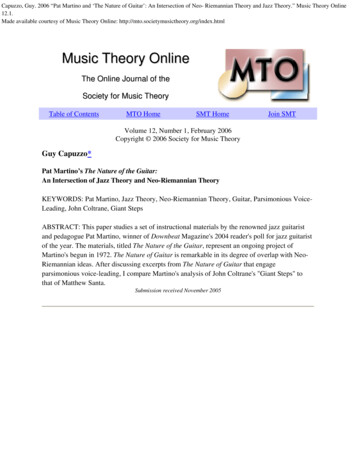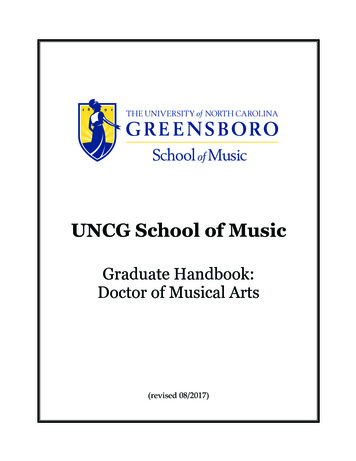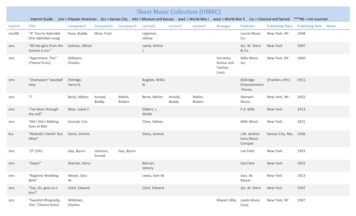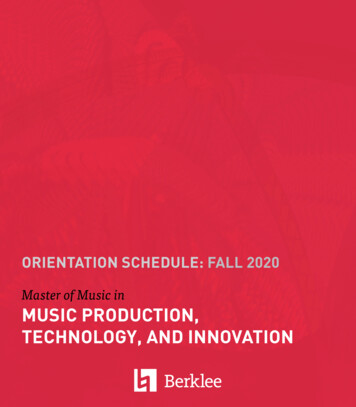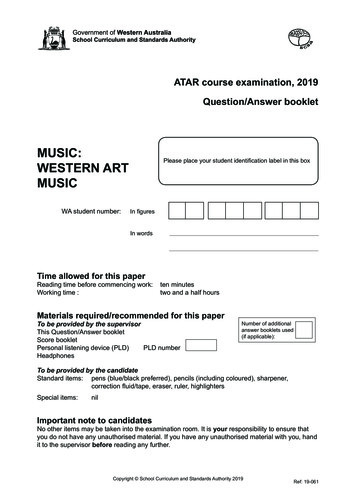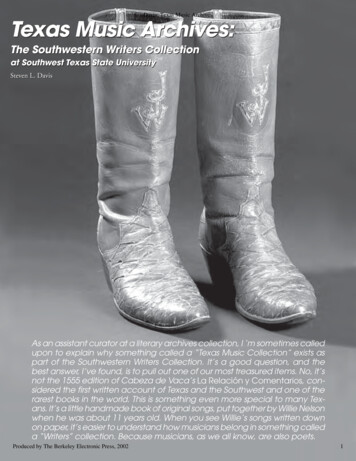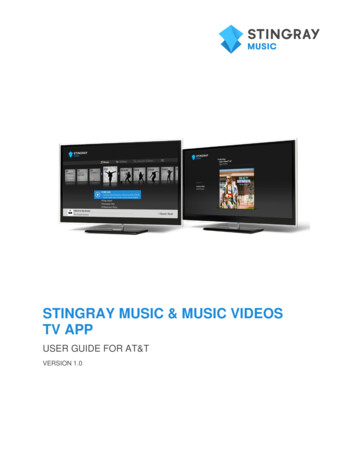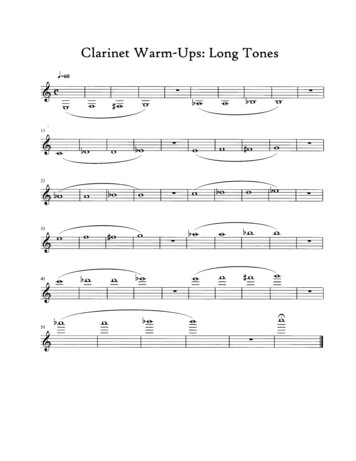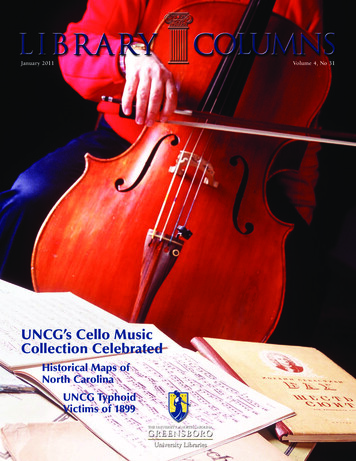
Transcription
January 2011Volume 4, No 31UNCG’s Cello MusicCollection CelebratedHistorical Maps ofNorth CarolinaUNCG TyphoidVictims of 1899
January 2011Volume 4, No 31IN THIS ISSUEFrom the Dean of University Libraries.1Helping Faculty Publish Online Journals .2Visitor from China .2UNCG Libraries Lend New Technology Products .3A Tale of Two Sisters .4UNCG—How Does Your Garden Grow?.5Cello Music Collections at Jackson Library.6UNCG Graduate Student and Cellist Leigh Rudner.7Documentary on Bernard Greenhouse .8Exhibits .8University Libraries Launch Digital Sheet Music Collection .9North Carolina’s Oldest Roads .10Collection Focus: North Carolina’s Stout Maps .11Focus Areas Chosen for Digital Projects.12AMONG FRIENDS .13To Lula, from Charlesby Bennie RobinsonNew Student Art Exhibit: Shifting GroundsFor the second year, Jackson Library featuresstudent art in the first floor reading room duringthe spring semester. UNCG Art Departmentstudents collaborated on this installation thatexplores the history of the university. Whileenrolled in the courses of Design II (taught byBryan Ellis), Alternative Photographic Process(taught by Leah Sobsey) and Books and Images(taught by Belinda Haikes), the students delvedinto the materials housed in the Martha BlakeneyHodges Special Collections and UniversityArchives. By incorporating photographs, historicalobjects, letters, documents, and oral history, thestudents’ art re-imagines the history of the campusand connects it to the present day.of the University LibrariesGifts That Keep on Giving .13Lee Smith and Hal Crowther Headline Friends Dinner .14Fostering Entrepreneurship in Libraries .16Celebrating Faculty Publications .17Author Panel Scheduled for February 21.18Randall Kenan to Conduct Reading .18Building a Legacy of Peace .20Project Documents African American Students .20Popcorn, Anyone?.21Take the Libraries With You .21UL/LIS Lecture Series Features Alum.22Libraries Offer Streaming Media 24/7.22Calendar.23The Cello Music Collections in Jackson Libraryare believed to be the largest collection of suchmaterials anywhere in the world.Exhibit Opening Reception: Thursday, January 20from 4-5:30 pm in the Jackson Library ReadingRoom. The exhibit will be on display through theSpring Semester. A percentage of all sales willbenefit the University Libraries.LIBRARY COLUMNS is published periodically by the University Libraries at TheUniversity of North Carolina at Greensboro. Our thanks to Garland Gooden forthe design of the publication. Thanks also to Kimberly Lutz for her assistance, andfor contributors noted throughout the publication. Please send your comments onthe issue to the editor at the address below.Barry Miller, Editorbarry miller@uncg.edu
from the Dean of University Librarieshis issue of Library Columns illustrates someof the services, programs, and values of theUniversity Libraries at UNCG. One of the Libraries’goals is always to create a community thatrecognizes and supports scholarship. Servicessuch as Open Access journals, NC DOCKS, ourfaculty book project, and our digital projects are keycomponents of our efforts to create that communityand make available the work of our scholars to thelarger academic and research community of whichwe are a part. The stories in this issue featuring ourmap collections, our cello music, and the poignantstory of the Bailey sisters illustrate the wealth of ourunique resources, including the treasures of ourMartha Blakeney Hodges Special Collections andUniversity Archives.In our local community, the Friends of the UNCGLibraries help us to extend our resources and services with programs such as lectures, book discussions,exhibit talks, and our Friends dinner, held eachspring since 1959. We hope that you will join us onMarch 16 when Lee Smith and Hal Crowther speak.Proceeds support the University Libraries.Our Libraries join our University and muchof our nation in our commitment to creating asustainable future. In addition to our activeinvolvement in the community garden on campus,the green library committee, and the campussustainability committee and film series, you willnote that even this magazine is now producedelectronically. In this time of belt tightening due tobudgetary pressures, we will continue to search forways both to save money and act sustainably.Several other stories indicate to us that you, ourcolleagues, patrons, and friends, are right there withus in achieving these goals. Our collections andservices make a difference to students, as cellist LeighRudner’s story indicates. They make a difference toalumni, as indicated by the championing of the institutional memory project by alumna and communitymember Brigitte Blanton and others. They make adifference to scholars such as Harold Schiffman andJane Perry-Camp, who donated not only Harold’sTpapers but also the important collection of composerEgon Wellesz. Our partnerships with communitygroups such as the International Civil RightsMuseum were reciprocated with a nice donation ofbooks at the opening of the recent “Gandhi, King,Ikeda: A Legacy of Building Peace”exhibit at theMuseum. Friends members Pam and David Sprinklehave made a strong statement of support andcommitment to our series by bringing an outstandingchildren’s book author and storyteller to the Triad fora series of programs and performances. These are buta few examples of your support and encouragement.The creation of the Jackson Society, our highest levelof giving, and the wonderful response to it, make usbelieve that you agree that we are doing the kinds ofthings that reflect our commitment to making theUniversity Libraries at UNCG the leading publicresearch library in the Triad.I want to close by saying that I am proud of ourLibraries, and grateful to all of you who patronizeand support us in our efforts. Thank you.Rosann Bazirjian, Dean of University LibrariesIn memoriamCharles W. Sullivan, member of the Boardof Directors of the Friends of the UNCG Libraries,died October 27, 2010. Like his beloved wife, formerUNCG Chancellor Pat Sullivan, he will be missed.1
The University Libraries and Open Journal Systems (OJS):Supporting Faculty Who Wish to Publish Online Journalsuring the spring of 2010, the UniversityLibraries acquired Open Journal Systems(OJS), a journal management and publishingsystem, and through the use of OJS, the Librariescan now support faculty who wish to publishonline journals, newsletters, technical report series,and other publications. The Journal of BackcountryStudies, founded and edited by Robert Calhoon, isthe first journal supported through the Libraries’use of OJS: http://libjournal.uncg.edu/ojsOJS was developed by the Public KnowledgeProject (PKP), a partnership of faculty members,librarians, and graduate students from SimonFraser University, the University of BritishColumbia, and Stanford University. OJS wasspecifically designed to assist faculty andresearchers in publishing peer-reviewedopen-access journals, and it supports journalmanagement through every stage of the peerreview and editorial process, from the submissionof each manuscript to the final publication of eachissue. OJS is open-source software and is freelyavailable on the Web: http://pkp.sfu.ca/?q ojsSupporting the entire management andpublication process, OJS provides for a widevariety of roles, with special features and functionsfor each. OJS roles include managers, editors,section editors, peer reviewers, copyeditors,layout editors, proofreaders, and when necessary,subscription managers. In addition, authors cansubmit their manuscripts on each journal’s homepage, and they can later log-in to follow the statusof their manuscripts in the review and publicationprocess. OJS supports all of these roles; however,depending on what the journal needs, particularroles can be utilized or not.The flexibility of OJS is one of its most importantfeatures. It can support peer-reviewed journals, butit also can support non-peer-reviewed publications,especially professional newsletters and technicalreports. OJS is specifically designed to supportopen-access publications, but it also can supportsubscription-based publications. In addition, thereDis a great flexibility in the number of individualswho can be involved with each publication. Alarge number of individuals can be involved in awide variety of roles (especially for peer-reviewedjournals); but, if there is no peer-review, a verylimited number of individuals can be involved,even just one or two (especially for newsletters,technical report series, etc.)In addition to the Journal of Backcountry Studies,faculty are currently working with library staff topublish other works using OJS, including TheInternational Journal of Critical Pedagogy, Women &Girls in Sport, the International Journal of NursePractitioner Educators, the Journal of Learning Spaces,the Journal of Applied Peace and Conflict Studies, theRichard Hogarth Society Newsletter, and UNCGTechnical Reports.Any faculty member interested in using OJSshould contact Stephen Dew, Collections &Scholarly Resources Coordinator, shdew@uncg.edu.Mr. Zhongming Xu, Special Assistant to theLibrary Director of the Tongji University Libraryand Associate Director ofthe Jiading CampusLibrary of the TongjiUniversity in China, visited the UNCG Librariesfrom September throughDecember 2010. His goalswere three-fold: to havea comprehensive understanding of the UNCGLibraries’ operations, including the collections,services, and management; to learn about ideas,methods, and the experiences of the UNCGLibraries in facilitating and supporting patrons'academic activities, such as the learning commons, subject librarians, institutional repositories,and outreach to the community; and to improvehis skill in speaking English. A planning teamchaired by Dr. Sha Li Zhang facilitated the visit.2
More Than Books: UNCG Libraries Lend New Technology Productsby Joe WilliamsIn September 2010, Jackson Library began lendingeight Apple iPads to UNCG students, faculty, andstaff. The iPads are just the latest addition to a smallbut growing Technology Checkout program in theLibraries, which includes laptops, graphing calculators, digital voice recorders, and digital camcorders.The new iPad has generated a lot of buzz sinceits release in early 2010. It delivers vivid, full colorgraphics—an Apple computing hallmark—as wellas touch screen navigation and a very slim, lightweight design. The Libraries’ iPads come with 16Gmemory and both Wi-Fi and Bluetooth connectivity. Libraries’ iPads circulate for four hours inside oroutside of the building and can be renewed once,provided no one else is waiting for a turn. The iPadsare configured basically like an iPad you mightpurchase and begin using “out of the box,”withjust two additional applications (“apps”) present:Wikipanion (an iPad-friendly version of Wikipedia)and Apple’s iBook reader for iPad, populated with ahandful of public domain book classics.Patrons that borrow a Libraries’ iPad are welcomeand encouraged to change settings, install apps,sync with personal iTunes accounts, and more.Since the iPad is a personal computing tool, wewant borrowers to get the full, personal experience.To ensure privacy, as iPads are returned to theCheckout Desk the Access Services staff memberscompletely erase that iPad’s hard drive and resetthe machine for the next patron.The University Libraries is continuouslyassessing patrons’academic and research-relatedtechnology needs. Previous surveys and interestgroups have led the Libraries to provide a variety oftechnologies to support our users, including largescreen LCD monitors, group-oriented furniture,and mobile, dry-erase marker boards. The newaddition of iPads has already been met with greatinterest and support.Between Sept. 22-Oct. 31, the iPads circulatedover 500 times. Since that time, some students haveprovided the Libraries with brief reviews of the iPadat the Libraries’ request. We asked them to speakparticularly to the academic uses—if any—that theyfound for this new technology. Several of them commented first on the size and mobility of the iPad.Ethan, a UNCG senior, wrote: “In some classrooms there isn’t enough room for a laptop ANDyour textbook. With the Ipad that wasn’t a problem,I was able to easily pull up the Powerpoints off ofBlackboard and follow along in class, while stillhaving plenty of room for my text book.”Andria, ajunior, said that the “best part about the ipad ishow easily it connects to the Internet and presentsnotes from your Blackboard account.” Blackboard isthe course management software used by UNCG—a secure online environment where faculty, staff,and students can meet in virtual classrooms, postand turn in assignments, chat and carry out discussions, or take/deliver a complete course online.“Instead of writing the call number down beforeentering the tower you can just walk with thedevice to your needed book,”said Amanda, aUNCG graduate student and avid Librariespatron.“This is a great research tool for anystudent on campus. I perused some of the journalarticles and library databases with ease.”Just as library materials have begun to appearmore commonly and frequently in electronicformats, the tools for accessing, searching, andorganizing that information have also continued tochange. In step with these changes, the Librariesgather input and feedback from our users on newand relevant services and technologies, searchingfor ways to support changing information-gatheringand -management needs. For more informationon the Libraries’ new iPads—and all of thetechnology the University Libraries lends—please visit our Technology Checkout web page,http://library.uncg.edu/services/technology checkout.aspx.Technology CheckoutThe University Libraries lend a growing number oftechnologies to UNCG students, faculty, and staff. Dueto high demand and limited quantities, patrons arelimited to borrowing one of these items at a time. Laptops iPads Camcorders Digital VoiceRecorders Graphing Calculators3
A Tale of Two Sistersby Kathelene McCarty Smithorking in the UNCG University29. Thomas Bailey took Sarah back toArchives, one comes in dailyMocksville for burial on Thanksgivingcontact with campus history. This wasDay. Sadly, five days before Christmas,the case when I came face to face withEvelyn also succumbed to the disease.two sets of portraits of Evelyn andIn the end, thirteen students and oneSarah Bailey. What was the signifidormitory matron were dead.cance of the paintings and why wereMr. Bailey remained loyal to thethey in the University Archives? I setschool, even agreeing to be on theabout to research their story. What IBoard of Directors. When thediscovered was one of the most tragicStudents’ Building, an early studentstories to emerge from the typhoidunion, was constructed on campus inepidemic that ravaged the school during1902, he was one of the major contributhe fall of 1899. Sarah and Evelyn Baileytors. He donated the funds for a memorialSarah Baileywere the only childrenroom, including all of the furnishings, andof Mr. and Mrs. Thomasa scholarship to honor his daughters.Bailey of Mocksville,Presumably, he commissioned theNorthCarolina.portraits at this time, but I could find noThomas Bailey, andocumentation to this effect. In fact,attorney, banker,there are no specific references to theand philanthropist,origins of the paintings; therefore,sent his daughterstheir history must be pieced together.Thomas Baileyto the State NormalIt seems likely that William Georgeand Industrial College (now UNCG)Randall, a North Carolina artist whofor their education. The sisters werehad created portraits of the schoolvery close and were constantly together.founders, painted both the large and theBoth girls were exemplary students andsmall oval portraits of Sarah and Evelynwere members of campus literary societiespictured here, probably from photographs. ItEvelyn Baileyand religious groups. Sarah was the eldesthas always been believed that the larger,and was described as a fine girl, one of the brightestmore formal paintings, showing the girls wearingin her class. Classmates found younger sister Evelyntheir literary society pins, hung in the Baileyquieter and dependent on her older sister. In herMemorial Room. Interestingly, early photographs ofapplication letter to the school, Evelyn requestedthe room do not include the portraits. Perhaps theyonly that she room with Sarah.were placed in the Bailey Residence Hall completedIn early November of 1899, over one hundredin 1922 and named after Thomas Bailey. It wouldstudents living in the two campus dormitories fell ill;seem that they remained on campus, eventuallySarah and Evelyn were among them. Soon after, thefinding their way to the Archives. The two smallerschool mourned the death of Linda Toms, a studentpaintings were apparently kept by the Bailey family,from Shelby. The campus physician, Dr. Anna Gove,but were later donated to the school. Tucked in withreported the cause of death as typhoid. At leastthe smaller paintings was a letter dated August,forty-eight cases of typhoid would eventually be1947, from Bertha Lee of Mocksville, a distantdiagnosed at the school. When their daughtersrelative of the Bailey girls, bequeathing them tobecame ill, Mr. and Mrs. Bailey immediately movedthe College for perpetual care and noting that ifto Greensboro to help care for them. Sarah’s condithey were not wanted, to please burn them.tion quickly deteriorated and she died on NovemberWe wanted them.W4
UNCG—How Does Your Garden Grow?verything old is new again. In the Fall semesterof 2010, students, faculty, and staff brokeground on a new food garden at 123 McIver Street.But food gardening on campus has a much longerhistory. As this photo shows,“Farmerettes”from theState Normal and Industrial College, as UNCG wasthen named, were lending their labor to producingfood for campus nearly 100 years ago in 1918.On Friday, April 15, we invite you to join us as wecelebrate and explore trends in gardening at UNCGand throughout the country. Carolyn Shankle willtrace the history of community food gardening, fromthe war gardens of World War I, to the victory gardensof World War II, to the urban gardens of the 1970s, ascaptured in the pamphlets and photographs housedin the Martha Blakeney Hodges Special CollectionsEand University Archives. Dr. Susan Andreatta,Professor of Anthropology and co-director of theUNC Greensboro Gardens, will discuss the creationof the new garden and how it supports the campusmove toward greater sustainability. Beth Filar Williamsand Sarah Dorsey will demonstrate the UniversityLibraries’resources for “green”gardening in ourcur
Girls in Sport, the International Journal of Nurse Practitioner Educators, the Journal of Learning Spaces, the Journal of Applied Peace and Conflict Studies, the Richard Hogarth Society Newsletter, and UNCG Technical Reports. Any faculty member interested in using OJS should contact Stephen Dew, Collections &

